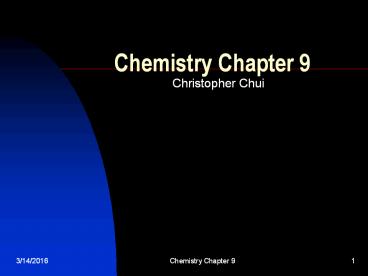Christopher Chui - PowerPoint PPT Presentation
1 / 6
Title:
Christopher Chui
Description:
Chemistry Chapter 9 Christopher Chui Early Attempts at Classification Dobereiner (1817) discovered groups of three elements with similar properties triad Triads ... – PowerPoint PPT presentation
Number of Views:89
Avg rating:3.0/5.0
Title: Christopher Chui
1
Chemistry Chapter 9
- Christopher Chui
2
Early Attempts at Classification
- Dobereiner (1817) discovered groups of three
elements with similar properties triad - Triads are Ca, Ba, Sr Cl, I, Br S, Te, Se
- Newlands (1863) law of octaves was proposed to
explain the repetition of similar properties that
occurred with every 8th element when the elements
were arranged in order of increasing atomic mass - Mendeleev (1869) correctly predicted properties
and masses of unknown elements - Mendeleev believed that the properties of the
elements were periodic functions of their atomic
masses
3
Modern Periodic Law
- The modern periodic law states that the
properties of the elements are a periodic
function of their atomic numbers (Moseley 1913) - Elements with similar electron configurations are
listed in the same column - Electron capacity s2, p6, d10, f14
- The transition elements fill columns 3-12
4
Lanthanoids and Actinoids
- Electrons are added to the 4f sublevel in the
lanthanoid series - Electrons are added to the 5f sublevel in the
actinoid series - Periods are horizontal rows of elements
- Groups are vertical columns of elements
- Eight electrons in the outer energy level of an
atom represent a stable arrangement - Helium, with 2 electrons, is included in the
octet rule - The periodic table can be used to determine the
electron configuration of an element
5
Electronic Configurations
- Atoms in the same period have the same principal
quantum number, n - Full or half-full sublevels are particularly
stable - Some deviations from the arrow diagram are
periodic and thus easily explained - Groups 1 and 2 contain the most active metals
- Metals generally have fewer electrons in the
outer level than non-metals
6
Groups of elements families
- Gp1 alkali metals Gp2 alkaline earth metals
Gp3-Gp12 transition metals Gp13-15 semimetals
and metals Gp16 chalcogens Gp17 halogens
Gp18 noble gases - Lanthanoids and actinoids are separate classes

